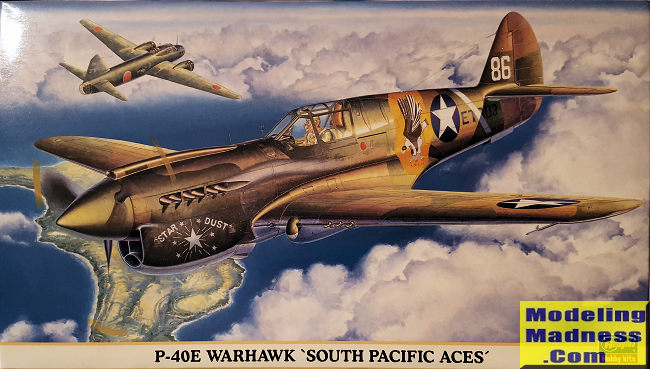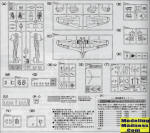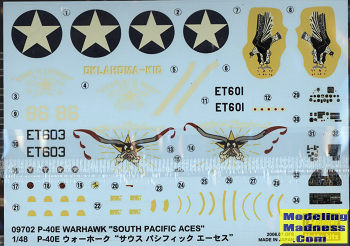
Hasegawa 1/72 P-40E Warhawk 'South Pacific Aces'
| KIT #: | 09702 |
| PRICE: | 2400 yen when new |
| DECALS: | Two options |
| REVIEWER: | Scott Van Aken |
| NOTES: | 2006 Limited Edition |

| HISTORY |
We all know that the P-40 was Curtiss' last really successful fighter. In fact, were it not for WWII, the P-40 may well have been built in relatively small numbers before the USAAC moved on to something else. However, the war did happen and Curtiss built thousands of P-40s in a rather bewindering number of variants. The more successful ones were from P-40E on. For lack of any other term, you can call these the 'big chin' versions as the oil cooler/radiator was much enlarged starting with the P-40D (of which few were built and I don't think any saw combat. The E model was the one which was really combat ready. It had self sealing fuel tanks and armor protection as well as the fire-power of six .50 caliber machine guns. It was fast in a dive and was relatively maneuverable at low level when pitted against European Axis aircraft. Against the Japanese, it was easy meat if it tried to maneuver against the much more agile Japanese aircraft.
Thanks to its rugged construction and more powerful engine, it was able to dive at high velocity, outrun the enemy and if it was hit, could take a lot of punishment before falling out of the sky. It was with the P-40 that the US went to war in the Pacific. The earlier versions were already in theater with the AVG and the Dutch, but those were not in US control. It was to Northern Australia that the 49th FG was deployed, later to move to New Guinea and to operate the P-40 through most of the war until mid 1944. The same situation befell the 23rd FG or what the AVG became in July of 1942. New Zealanders were a major operator of the type, mostly as ground attack aircraft.
Though mostly out of frontline combat with US units by early 1945, the P-40 soldiered on in the hands of Allies until war's end. Once the war was over, thousands of P-40s became little more than scrap with a few ending up in museums and the hands of war bird owners.
| THE KIT |
 The
kit has more inserts than a Sunday newspaper and one can only hope that the fit
of all these is up to snuff. There are separate sprues for the tail, the gun
inserts, the ejector chute inserts, the windscreen, canopy and backlight. Same
goes for the exhaust and prop and instrument panel. There are options for clear
wing tip lights (you have to cut off the old ones) a gun camera, drop tank and
bomb. Two styles of wheels are provided, both spoked and covered, though I
suppose the spoked versions are for later kits. Unlike other P-40E kits,
the braces for the bomb and the drop tank are different to take into
consideration the different shapes. The cowl flaps are also molded in the open
position. The prop looks like the tips may be a bit more rounded than I'm used
to seeing in P-40 kits, but may well be more accurate.
The
kit has more inserts than a Sunday newspaper and one can only hope that the fit
of all these is up to snuff. There are separate sprues for the tail, the gun
inserts, the ejector chute inserts, the windscreen, canopy and backlight. Same
goes for the exhaust and prop and instrument panel. There are options for clear
wing tip lights (you have to cut off the old ones) a gun camera, drop tank and
bomb. Two styles of wheels are provided, both spoked and covered, though I
suppose the spoked versions are for later kits. Unlike other P-40E kits,
the braces for the bomb and the drop tank are different to take into
consideration the different shapes. The cowl flaps are also molded in the open
position. The prop looks like the tips may be a bit more rounded than I'm used
to seeing in P-40 kits, but may well be more accurate.
In terms of glitches, there were not many. There are tiny ejector pin marks in the separate wheel wells and my seat frame had been broken in half by all the sprues banging around in the bag. I also found some sink areas under the wing and the ejector pin holes are so deep on the inside of the wing that there are impressions of them on the outside. They will probably disappear under paint. I do like having the gun barrels already drilled out and wish they could have done the same with the exhaust stubs. I also found ejector pin marks on the wheels and the landing gear.
What isn't offered are separate flaps, and this is just
fine as the vast majority of P-40 photos you see have these raised when parked.
Other inserts are for the cooling vents (or lack of in the forward nose, the
carb intake, and you'll have to plug a few holes, drill a few holes, and trim a
part or two during the construction.
Instructions are what are now standard fare with Gunze color references. Both markings options are with the 49th FG and are planes that were originally built for the British. As such, they have US equivalent camouflage of dark earth, dark green upper surfaces. One option has neutral grey undersides while the other has azure blue. Decals are nicely printed though the white areas are actually an off-white. Despite their age, they should still function well.
| CONCLUSIONS |
I've built this kit a couple of times in various versions and found it to be generally a very nice fitting kit. It is one that could benefit from an upgraded interior or at least a seat harness, but looks great right from the box.
July 2022
Copyright ModelingMadness.com. All rights reserved. No reproduction in part or in whole without express permssion from the editor.
If you would like your product reviewed fairly and fairly quickly, please contact the editor or see other details in the Note to Contributors.